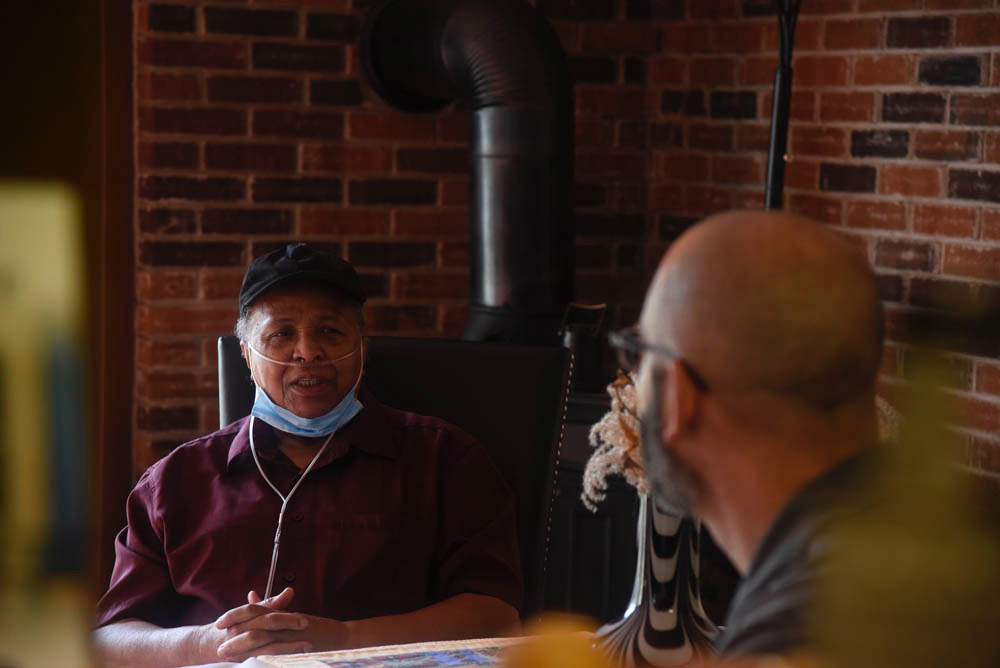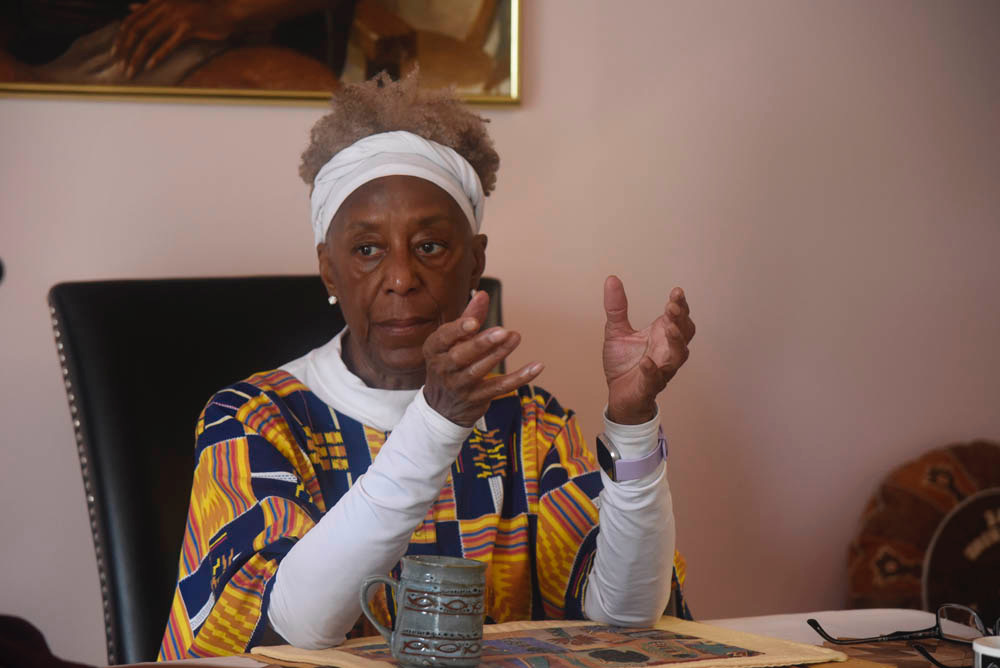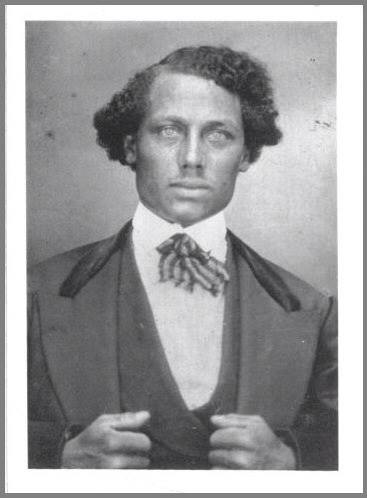
Mayle smiles with pride in his office as he stands in front of the posters hanging on his wall.
The experience of being Black in Appalachia is too vast to truly capture by one person, but the roots of its history run deep in the region. Although some might consider the history of Black Appalachia to be scarce, it is everywhere if one looks hard enough.
Foundation of Black Preservation

Three people sit around a dining room table, sharing their knowledge and experience of Black Appalachia with one another. Ada-Woodson Adams, president of the Mount Zion Baptist Church Preservation Society (MZBCPS), sits across from William Isom ll, the director of Black in Appalachia, an organization that highlights the history and contributions of African Americans. Between them, at the head of the table, sits Trevellya “Tee” Fordahmed, Ph.D., a Black Appalachian from West Virginia and current citizen of Athens.
“I’m also connected with The Multicultural Genealogical Center in Chester Hill,” Adams says to Isom. “There’s an escape room that has to do with the Underground Railroad and how people saw their way to freedom.”
The Multicultural Genealogical Center serves as a tourist attraction and research center for Black history and the Underground Railroad. This center, along with the MZBCPS, are major contributions to the region thanks to the Adams family.
According to the MZBCPS website, the preservation society is a non-profit organization with goals to restore the Mount Zion Church, hopeful that it will serve as a vibrant community center. In the early 2000s, the church disbanded, leaving the Black community in Athens with nowhere to gather. In 2013, the MZBCPS was formed by Ada-Woodson Adams, Ron Luce, Linda Philips and Henry Woods to recreate the community space for people all over the region.
The goal of the MZBCPS is to serve as a space for people to learn and connect with one another. The board of the church works hard to educate and provide programming that supports the Black community and other marginalized groups in Southeast Ohio. Ford-Ahmed points out the motto of the church that says, “Building our future by preserving our past.”
The Bottom

Fordahmed has dedicated herself to this motto and mission through her connection to the MZBCPS and Appalachia. She was born in West Virginia and says that people don’t think that Black people live in Appalachia. She thinks ideas of Appalachia circulate around the “Coal Miner’s Daughter” and Loretta Lynn, a singer-songwriter from Kentucky.
“But there were a lot of Black coal miners,” she says. “My dad was a coal miner and he was a union man, and we lived in what you call ‘the bottom.’”
People called it “the bottom” because it was a flat area located in the hills of West Virginia. Fordahmed says the white people, lived further away, separated by a railroad track and a river. The bottom was home to people of lower income. The Black school was also in the bottom, enriching the experiences she had growing up there.
Fordahmed’s family was the only Black family that lived in her area. There were around 40 coal mining houses and all of her neighbors were white. The Black families from other hollers came to her neighborhood to attend school. Fordahmed began attending school at 3 years old and the other Black kids would come to her house and take her to school.
“I was kind of like the mascot that they would bring to school.” Fordahmed says. “I think that being a mascot or whatever really helped to establish my view of myself. I felt very valued. And my feeling of self-worth and everything was pretty high. And it stayed that way, I think, until integration happened.”
Eventually she was enrolled in a school of about 500 students where she was one of roughly 12 Black students. Fordahmed says that this is when she realized that things were different than she thought they were growing up. Even though she grew up around white families, her father was revered for being a union man, so going to this school was different for her. She began to see the ways that the color of her skin influenced the way she was treated by others.
She explains that her teachers were almost always mean. The French and choir teachers were the only ones that were nice, which she credits to them being “of international orientation” and having the job of bringing voices together.
“I had a history teacher that would erase my answers and even change my answers so that I would not make an A on a test,” Fordahmed says.
Family Connections
Tony Mayle, the associate dean of students and director of diversity and inclusion at Marietta College, is committed to his ancestry and roots. Mayle grew up in Morgan County, deep in the hills of Appalachia. As the son of an interracial couple, his family’s experience is unique.
The Mayle lineage begins in Philippi, West Virginia, extending into Michigan and other parts of West Virginia, making up one of the biggest multiracial families in Southeast Ohio. Mayle’s mother, who is German, and his father, who is African American, left their home in Morgan County to get married legally. He was raised in a household of women, by his mother and the family of his father.
He says that being a person of color in Appalachia is not just about identifying as one, but about the cultural aspect of it. Growing up, Mayle lived off the land by foraging and planting, a tradition that has been carried on through generations and a practice that he still participates in today. The Mayle family is so large, however, that the name and traditions do not always look and sound the same.
“There are many reasons for that,” Mayle says. “Some people want to escape the racism that they’ve been involved in. So, some will change the spelling or pronunciation. Some can pass quote-unquote, pass for another race, whether it be white or whether it be Native American.”
Mayle points out that he is lightly complected and identifies as Melungeon, a term that describes people from the Eastern United States with Western European, African American and Native American ancestry. As a triracial family, the members of the Mayle lineage fall on a spectrum in terms of skin tones and hues, allowing for the choice to “pass” as another race. This also creates a space for each member of the family to have different cultural beliefs and practices.
The Mayles are connected to many other families, including the family of Henry Louis Gates Jr. According the Harvard University website, Gates is an “Emmy and Peabody Award-winning filmmaker, literary scholar, journalist, cultural critic, and institution builder,” as well as a professor at the university. He focuses much of his time and energy on creating cultural competency and sharing Black stories.
Mayle firmly believes in this kind of education of Black life and culture. The African word Sankofa translates to, “Always remember the past for therein lies the future, if forgotten … we are destined to repeat it.” Mayle has reminders of this word around his office. The Sankofa is also an East African symbol from Ghana that Mayle finds significant to Black history.
“The bird – if you see the bird’s body–the body is facing forward, the head’s facing backwards, symbolizing [that] in order for us to go forward, we have to reach back and grab what we lost,” Mayle says. “We have to know our history. We have to know our ancestry.”
He also points out the egg in the bird’s mouth, symbolizing that the youth should know their genealogy and ancestry. It is easy for people to trace their white ancestry all the way back to Europe, but it is much harder to trace African and African American ancestry. Mayle and many other Black people rely on Civil War records to trace their bloodlines. Even that presents challenges, however, because slaves who were in servitude were considered property.

Mayle shares similar stories as Ford-Ahmed about teachers in his community making assumptions about the Mayle family and other Black families based on their name. Each last name had certain connotations to them, which led teachers to assume that a child would be smart or was poor. One of his childhood memories sheds light on the negative side of the Black Appalachian experience, similar to Ford-Ahmed, when the Ku Klux Klan committed a hate crime in his yard.
“One of my earliest remembrances growing up with my mother and father being together was looking out the back door, seeing a bright light and looking at my mom,” Mayle says. “I asked her what that light was as she was cooking in the kitchen and seeing tears run down her eyes. It was a cross being burned in our backyard.”
He points out that this occurred in the 1970s and shared that things like that still happen today. Students still receive threats for dating outside of their race. There are also many Confederate and derogatory Native American mascots in the area, Mayle says.
The Black Appalachian Identity
Adams and Isom echo the same ideas of Mayle and Fordahmed. Through Black in Appalachia and being the chair of the Appalachian African-American Cultural Center, Isom is able to connect with Adams and Ford-Ahmed and the history they each strive to uphold.
Isom grew up in rural Eastern Tennessee, playing in the creek and messing with the neighbors’ cows. There was a spattering of Black families in the rural areas, he says, but he went into Morristown to spend time with the majority of his friends. He didn’t realize how much his upbringing impacted him until he left his hometown for Middle Tennessee State University.
“Growing up in Appalachia has shaped my identity. It’s everything that I am…”, he says. “I didn’t fully realize it when I went off to college, I didn’t understand. I didn’t understand that where I was from was unique.”
He knew his accent set him apart and some of his experiences wouldn’t be the same, but he didn’t anticipate some of the treatment he received. People pointed at him and laughed, didn’t understand terms like ‘holler’ and couldn’t relate to stories of growing tobacco. At first, he wanted to rid his identity of these things for the sake of fitting in, but then he realized that those things make him who he is.
This year, Black in Appalachia celebrates its 10-year-anniversary.
“We do everything we can to grab these pieces and parts of Black history that are scattered all over the place to quilt those together to tell our narratives,” Isom says.
There is not a lack of information, he says. The challenge is that it is hard to find. People are not considering Black mountaineers or Black people in the mountain south. There is a lot of rich history to discover and the goal of Black in Appalachia is to compile the information and assist communities in telling their own stories. Isom says that the top-notch reward of his job would be an eighth grader using the research that the organization has compiled to write a paper for school.
Isom, along with Mayle, Fordahmed and Adams, is deeply connected to his roots. Each of them spend their days researching, preserving and advocating for the Black history of Appalachia. These roots connect them with their individual histories and with each other.
“It’s important for me to be connected to my roots because that’s all I got,” Isom says. “You know, I’m ripping and running and having fun, but at some point, I think things get kind of stripped away, and you start to be able to see, over time, what’s valuable.”

